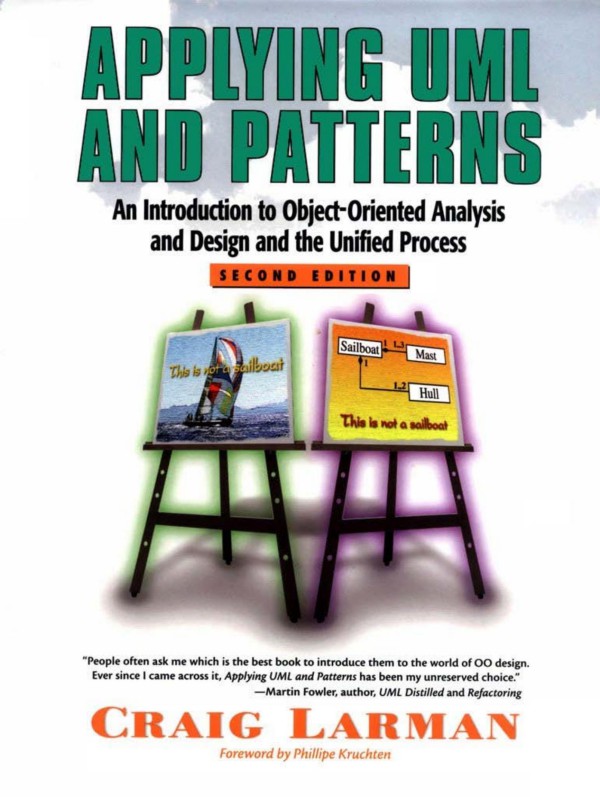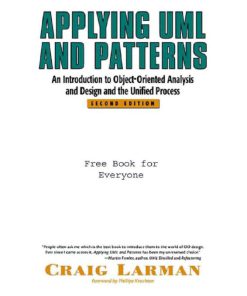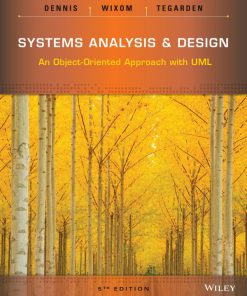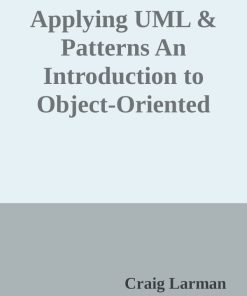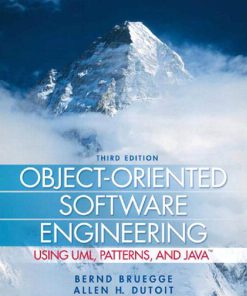Applying UML and Patterns An Introduction to Object Oriented Analysis and Design and Iterative Development 3rd Edition by Craig Larman ISBN 0131489062 9789332553941
$50.00 Original price was: $50.00.$25.00Current price is: $25.00.
Authors:Craig Larman , Series:IT & Computer [454] , Tags:Computer Engineering; Information Technology , Author sort:Larman, Craig , Ids:Google; 9789332553941 , Languages:Languages:eng , Published:Published:Mar 2016 , Publisher:Pearson , Comments:Comments:Larman covers how to investigate requirements, create solutions and then translate designs into code, showing developers how to make practical use of the most significant recent developments. A summary of UML notation is included
Applying UML and Patterns: An Introduction to Object-Oriented Analysis and Design and Iterative Development 3rd Edition by Craig Larman – Ebook PDF Instant Download/Delivery. 0131489062, 9789332553941
Full download Applying UML and Patterns: An Introduction to Object-Oriented Analysis and Design and Iterative Development 3rd Edition after payment
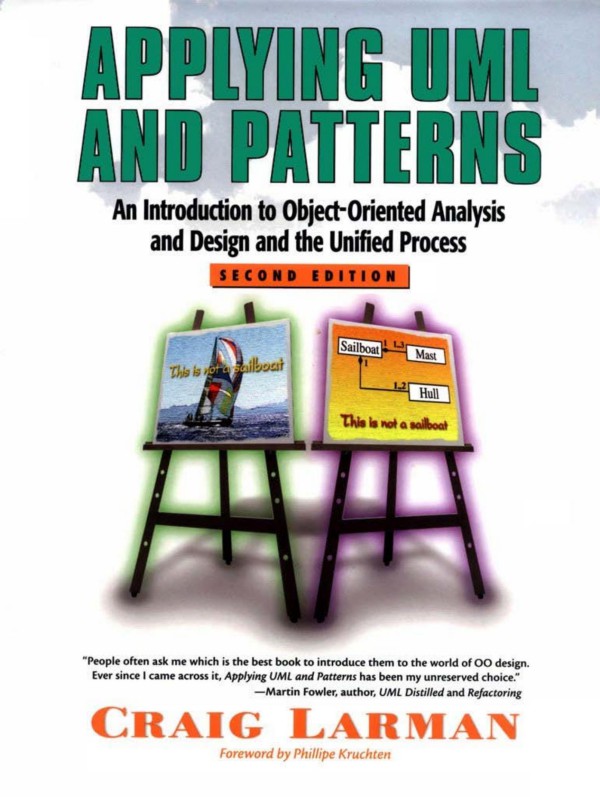
Product details:
ISBN 10: 0131489062
ISBN 13: 9789332553941
Author: Craig Larman
“This edition contains Larman’s usual accurate and thoughtful writing. It is a very good book made even better.”
―Alistair Cockburn,author,Writing Effective Use CasesandSurviving OO Projects“Too few people have a knack for explaining things. Fewer still have a handle on software analysis and design. Craig Larman has both.”
―John Vlissides,author,Design PatternsandPattern Hatching“People often ask me which is the best book to introduce them to the world of OO design. Ever since I came across it Applying UML and Patterns has been my unreserved choice.”
―Martin Fowler,author,UML DistilledandRefactoring“This book makes learning UML enjoyable and pragmatic by incrementally introducing it as an intuitive language for specifying the artifacts of object analysis and design. It is a well written introduction to UML and object methods by an expert practitioner.”
―Cris Kobryn,Chair of the UML Revision Task Force and UML 2.0 Working Group
- A brand new edition of the world’s most admired introduction to object-oriented analysis and design with UML
- Fully updated for UML 2 and the latest iterative/agile practices
- Includes an all-new case study illustrating many of the book’s key points
Applying UML and Patterns is the world’s #1 business and college introduction to “thinking in objects”―and using that insight in real-world object-oriented analysis and design. Building on two widely acclaimed previous editions, Craig Larman has updated this book to fully reflect the new UML 2 standard, to help you master the art of object design, and to promote high-impact, iterative, and skillful agile modeling practices.
Developers and students will learn object-oriented analysis and design (OOA/D) through three iterations of two cohesive, start-to-finish case studies. These case studies incrementally introduce key skills, essential OO principles and patterns, UML notation, and best practices. You won’t just learn UML diagrams―you’ll learn how to apply UML in the context of OO software development.
Drawing on his unsurpassed experience as a mentor and consultant, Larman helps you understand evolutionary requirements and use cases, domain object modeling, responsibility-driven design, essential OO design, layered architectures, “Gang of Four” design patterns, GRASP, iterative methods, an agile approach to the Unified Process (UP), and much more. This edition’s extensive improvements include
- A stronger focus on helping you master OOA/D through case studies that demonstrate key OO principles and patterns, while also applying the UML
- New coverage of UML 2, Agile Modeling, Test-Driven Development, and refactoring
- Many new tips on combining iterative and evolutionary development with OOA/D
- Updates for easier study, including new learning aids and graphics
- New college educator teaching resources
- Guidance on applying the UP in a light, agile spirit, complementary with other iterative methods such as XP and Scrum
- Techniques for applying the UML to documenting architectures
- A new chapter on evolutionary requirements, and much more
Applying UML and Patterns, Third Edition, is a lucid and practical introduction to thinking and designing with objects―and creating systems that are well crafted, robust, and maintainable.
Applying UML and Patterns: An Introduction to Object-Oriented Analysis and Design and Iterative Development 3rd Table of contents:
Chapter 1: Introduction to Object-Oriented Design and UML
- What is Object-Oriented Analysis and Design (OOAD)?
- Key Concepts in Object-Oriented Design
- Introduction to the Unified Modeling Language (UML)
- Benefits of Object-Oriented Development and UML
- The Role of Patterns in Object-Oriented Design
- Overview of Iterative Development
Chapter 2: Use Case Modeling
- What is a Use Case?
- The Role of Use Cases in Object-Oriented Design
- Creating Use Case Diagrams and Descriptions
- Actors and System Boundaries
- Extending and Refining Use Cases
- Use Case Realization and the Role of UML
Chapter 3: Object-Oriented Analysis
- The Process of Object-Oriented Analysis
- Analyzing System Requirements Using Use Cases
- Identifying Objects, Attributes, and Operations
- Modeling System Behavior: Interaction and State
- Iterating and Refining the Object Model
- Documenting Analysis Models
Chapter 4: Class and Object Design
- Introduction to Class and Object Design
- Defining Classes, Attributes, and Operations
- Relationships Between Classes: Associations, Aggregation, and Inheritance
- Encapsulation and Information Hiding
- Designing for Reusability and Flexibility
- Designing Interfaces and Abstract Classes
Chapter 5: Design Patterns
- What Are Design Patterns?
- Categories of Design Patterns:
- Creational Patterns
- Structural Patterns
- Behavioral Patterns
- The Singleton Pattern
- The Factory Pattern
- The Observer Pattern
- The Strategy Pattern
- Applying Design Patterns to Common Design Problems
Chapter 6: Sequence Diagrams and Interaction Modeling
- Introduction to Sequence Diagrams
- Modeling Object Interactions and Communication
- Lifelines, Activation Bars, and Messages
- Describing System Behavior and Timing
- Creating Sequence Diagrams from Use Cases
- Best Practices for Interaction Modeling
Chapter 7: State Diagrams and State Machines
- The Role of State Machines in Object-Oriented Design
- Modeling Objects’ States and State Transitions
- Events, Guards, and Actions in State Diagrams
- The Role of State Diagrams in Modeling Object Behavior
- Using State Diagrams for Workflow and Process Modeling
Chapter 8: Component and Deployment Models
- Component Diagrams and Their Purpose
- Modeling Software Components and Interfaces
- Component Relationships and Dependency Modeling
- Deployment Diagrams and System Architecture
- Mapping Software Components to Hardware
- Using Component and Deployment Diagrams in Iterative Development
Chapter 9: Iterative Development
- What is Iterative Development?
- The Unified Process: Phases and Iterations
- Key Concepts in Iterative and Incremental Development
- Using UML Models in Iterations
- Prototyping, Feedback, and Refinement
- Managing Requirements and Design in Iterations
Chapter 10: Architectural Design
- Principles of Software Architecture
- High-Level Design and Architectural Styles
- Component-Based and Layered Architectures
- Modeling Architecture Using UML
- Evaluating and Refining Architectural Decisions
- Architectural Patterns and Their Applications
Chapter 11: Advanced Design Patterns
- Advanced Creational Patterns: Abstract Factory and Builder
- Advanced Structural Patterns: Composite and Proxy
- Advanced Behavioral Patterns: Command, Chain of Responsibility, and State
- Applying Patterns to Complex Design Problems
- Refactoring and Improving Design with Patterns
Chapter 12: Design and Analysis Techniques in Practice
- Applying UML to Real-World Design Problems
- Case Study: Designing an Online Shopping System
- Case Study: Developing a Customer Relationship Management (CRM) System
- Applying Patterns in Design: A Practical Example
- Iterative Design in Practice: Building and Refining Systems
Chapter 13: Testing and Quality Assurance in Object-Oriented Design
- The Role of Testing in Object-Oriented Development
- Unit Testing and Test-Driven Development (TDD)
- Integration and System Testing
- Patterns for Writing Testable Code
- Quality Assurance Practices for Object-Oriented Systems
Chapter 14: Refining and Evolving Designs
- Iterative Design and Continuous Improvement
- Refactoring and Improving Object-Oriented Designs
- Identifying and Solving Design Problems
- Evolving Designs in an Agile Environment
- Maintaining and Enhancing Software Over Time
People also search for Applying UML and Patterns: An Introduction to Object-Oriented Analysis and Design and Iterative Development 3rd:
applying uml & patterns
applying uml and patterns 3rd edition pdf
applying uml and patterns by craig larman
applying uml and patterns by craig larman pdf
applying uml and patterns github

